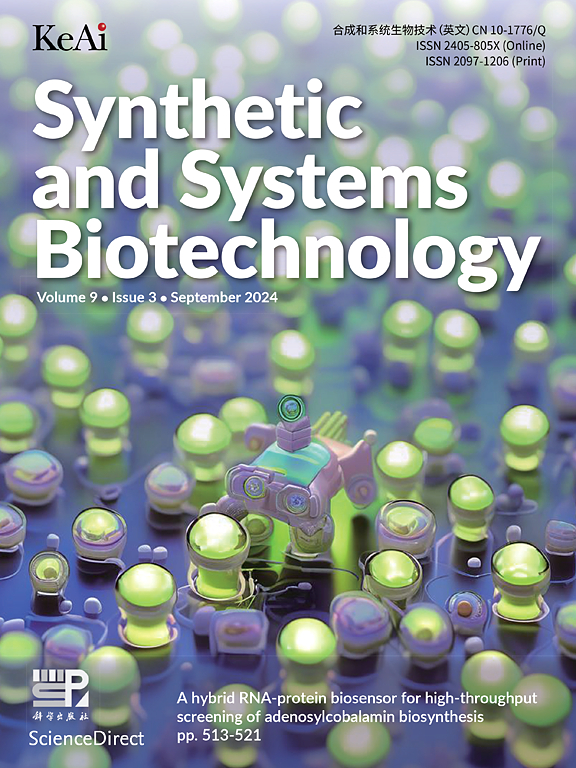一种nadph依赖性羰基还原酶在酿酒酵母AS2.346中的鉴定、表征和应用,以提高(13R,17S)-乙二醇的产量
IF 4.4
2区 生物学
Q1 BIOTECHNOLOGY & APPLIED MICROBIOLOGY
引用次数: 0
摘要
左炔诺孕酮是目前使用最广泛的避孕药,具有口服吸收快、生物利用度高等优点。在其生产所采用的多种合成方法中,Saccharomyces cerevisiae AS2.346最早由中国科学院上海有机化学研究所于1976年引入,成功催化乙二酮转化为(13R,17S)-乙二醇。目前左炔诺孕酮工业生产仍采用酿酒酵母AS2.346全细胞催化。为了确定催化乙基二酮转化为(13R,17S)-乙基二醇的酶,我们分离了两个编码羰基还原酶的基因Assdr1和Assdr2。AsSDR1和AsSDR2的生化特性表明它们对乙二酮具有较高的活性。功能分析表明,Assdr1的缺失几乎完全消除了(13R,17S)-ethyl secol的产生,而Assdr2的缺失对其产生几乎没有影响,这表明Assdr1在(13R,17S)-ethyl secol的生物合成中起着关键作用。AsSDR1和AsSDR2在体内功能差异的原因可能是它们的细胞定位不同,AsSDR1位于线粒体外,而AsSDR2位于线粒体内。对Assdr1基因敲除菌株的代谢组学分析显示,Assdr1可能是一种蝶呤蛋白还原酶。新分离基因Assdr1的过表达使其产量比野生型平均提高47.88% (13R,17S)。此外,通过过表达编码线粒体NADH激酶的截短基因pos5Δ17来改造NADPH辅助因子的代谢,与野生型菌株相比,提高了111.25%的(13R,17S)-乙二醇产量。这些发现不仅阐明了参与(13R,17S)-乙二醇合成的关键酶,而且为优化左炔诺孕酮生产的工业生物转化过程提供了框架。本文章由计算机程序翻译,如有差异,请以英文原文为准。
Identification, characterization, and application of an NADPH-dependent carbonyl reductase in Saccharomyces cerevisiae AS2.346 for improving production of (13R,17S)-ethyl secol
Levonorgestrel is currently the most widely used contraceptive, with advantages that include rapid oral absorption and high bioavailability. Among the various synthetic methods employed in its production, Saccharomyces cerevisiae AS2.346 was first introduced by the Shanghai Institute of Organic Chemistry, Chinese Academy of Sciences, in 1976, successfully catalyzing the conversion of ethyl secodione to (13R,17S)-ethyl secol. Presently, Saccharomyces cerevisiae AS2.346 whole-cell catalysis is still used in levonorgestrel industrial production. To identify the enzyme responsible for catalyzing the conversion of ethyl secodione to (13R,17S)-ethyl secol, we isolated two genes, Assdr1 and Assdr2, both encoding carbonyl reductases. The biochemical characterization of AsSDR1 and AsSDR2 showed that they had high activity for ethyl secodione. Functional analysis demonstrated that the deletion of Assdr1 almost completely abolished the production of (13R,17S)-ethyl secol, while the deletion of Assdr2 had little to no effect on the production, indicating that Assdr1 plays a pivotal role in the biosynthesis of (13R,17S)-ethyl secol. The reason for the difference in the function of AsSDR1 and AsSDR2 in vivo may be attributed to their different cellular localizations, with AsSDR1 located outside the mitochondria and AsSDR2 in the mitochondria. A metabolomics analysis of Assdr1 knockout strains revealed that AsSDR1 may act as a pterin reductase. Overexpression of the newly isolated gene Assdr1 led to an average 47.88 % higher (13R,17S)-ethyl secol yield compared to that of the wild-type strain. Furthermore, engineering the metabolism of the NADPH cofactor by overexpressing the truncated gene pos5Δ17 encoding mitochondrial NADH kinase produced a 111.25 % higher (13R,17S)-ethyl secol yield compared to that of the wild-type strain. These findings not only elucidate the key enzymatic players involved in the synthesis of (13R,17S)-ethyl secol but also provide a framework for optimizing the industrial biotransformation process for levonorgestrel production.
求助全文
通过发布文献求助,成功后即可免费获取论文全文。
去求助
来源期刊

Synthetic and Systems Biotechnology
BIOTECHNOLOGY & APPLIED MICROBIOLOGY-
CiteScore
6.90
自引率
12.50%
发文量
90
审稿时长
67 days
期刊介绍:
Synthetic and Systems Biotechnology aims to promote the communication of original research in synthetic and systems biology, with strong emphasis on applications towards biotechnology. This journal is a quarterly peer-reviewed journal led by Editor-in-Chief Lixin Zhang. The journal publishes high-quality research; focusing on integrative approaches to enable the understanding and design of biological systems, and research to develop the application of systems and synthetic biology to natural systems. This journal will publish Articles, Short notes, Methods, Mini Reviews, Commentary and Conference reviews.
 求助内容:
求助内容: 应助结果提醒方式:
应助结果提醒方式:


